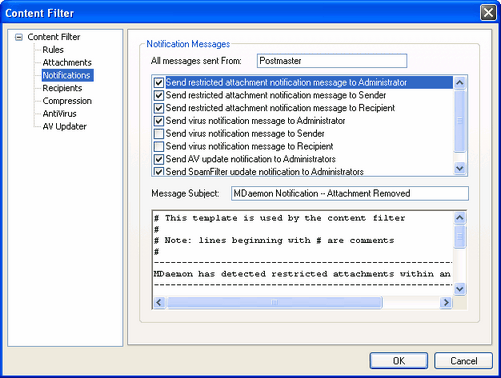
Used this tab to designate those who should receive notification messages when a virus or restricted attachment is detected.
Notification Messages
All messages sent From:
Use this box for specifying the address from which you wish the notification messages to be sent.
Send virus notification message to...
When a message arrives with a file attachment containing a virus, a warning message will be sent to the individuals designated in this section. A customized warning message can be sent to the sender, recipient, and the administrators that you have designated on the Recipients tab. To customize the message for any of the three entries, select one of them from the list and then edit the message that appears on the bottom half of this tab. Each entry has its own message, though by default this isn't obvious since all three are identical.
Send restricted attachment notification message to...
When a message arrives with a file attachment matching a restricted attachment entry (listed on the Attachments tab) a warning message will be sent to the individuals designated in this section. A customized warning message can be sent to the sender, recipient, and the administrators that you have designated on the Recipients tab. To customize the message for any of the three entries, select one of them from the list and then edit the message that appears on the bottom half of this tab. Each entry has its own message, though by default this isn't obvious since all three are identical.
Message Subject:
This text will be displayed in the "Subject:" header of the notification message that is sent.
Message
This is the message that will be sent to the entry selected in the list above when the checkbox corresponding to that entry is enabled. You can directly edit this message from the box in which it is displayed.
|
|
The actual files
containing this text are located in the MDaemon\app\ directory. They are: |
Message Macros
For your convenience, certain macros may be used in the notification messages and other messages that the Content Filters generate. You may use any of the following macros:
|
$ACTUALTO$ |
Some messages may contain an "ActualTo" field which generally represents the destination mailbox and host as it was entered by the original user prior to any reformatting or alias translation. This macro is replaced with that value. |
|
$AV_VERSION$ |
Lists the version of SecurityPlus for MDaemon that you are using. |
|
$CURRENTTIME$ |
This macro is replaced with the current time when the message is being processed. |
|
$ACTUALFROM$ |
Some messages may contain an "ActualFrom" field which generally represents the origination mailbox and host prior to any reformatting or alias translation. This macro is replaced with that value. |
|
$FILTERRULENAME$ |
This macro is replaced by the name of the rule whose criteria the message matched. |
|
$HEADER:XX$ |
This macro will cause the value of the header specified in place of the "xx" to be expanded in the reformatted message. For example: If the original message has "TO: joe@mdaemon.com" then the $HEADER:TO$ macro will expand to "joe@mdaemon.com". If the original message has "Subject: This is the subject" then the $HEADER:SUBJECT$ macro would be replaced with the text "This is the subject" |
|
$HEADER:MESSAGE-ID$ |
As with $HEADER:XX$ above, this macro will expand to the value of the Message-ID header. |
|
$LIST_ATTACHMENTS_REMOVED$ |
When one or more attachments are removed from the message, this macro will list them. |
|
$LIST_VIRUSES_FOUND$ |
When one or more viruses is found in a message, this macro will list them. |
|
$MESSAGEFILENAME$ |
This macro expands to the file name of the current message being processed. |
|
$MESSAGEID$ |
As $HEADER:MESSAGE-ID$ above, except this macro strips "<>" from the value of the message ID. |
|
$PRIMARYDOMAIN$ |
Expands to MDaemon's Default Domain name, which is designated on the Default Domain Configuration dialog (click SetupàDefault Domain). |
|
$PRIMARYIP$ |
This macro expands to the IP address of your Default Domain (specified on the Default Domain Configuration dialog) |
|
$RECIPIENT$ |
This macro resolves to the full address of the message recipient. |
|
$RECIPIENTDOMAIN$ |
This macro will insert the domain name of the message recipient. |
|
$RECIPIENTMAILBOX$ |
Lists the recipient's mailbox (the value to the left of "@" in the email address). |
|
$REPLYTO$ |
This macro expands to the value of the message's "Reply-to" header. |
|
$SENDER$ |
Expands to the full address from which the message was sent. |
|
$SENDERDOMAIN$ |
This macro will insert the domain name of the message's sender (the value to the right of "@" in the email address). |
|
$SENDERMAILBOX$ |
Lists the sender's mailbox (the value to the left of "@" in the email address). |
|
$SUBJECT$ |
Displays the text contained in the message's subject. |